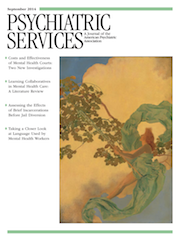Psychiatrists’ Judgments About Antipsychotic Benefit and Risk Outcomes and Formulation in Schizophrenia Treatment
Abstract
Objective
The objectives were to quantify psychiatrists’ judgments of the benefits and risks of antipsychotic treatments of patients with schizophrenia and to evaluate how patient adherence history affects these judgments.
Methods
Weights assigned by respondents to risks, benefits, and alternative drug formulations in the treatment of schizophrenia were assessed via a Web-based survey by using a discrete-choice experiment. Respondents in the United States and the United Kingdom chose among alternative scenarios characterized by various levels of improvement in positive symptoms, negative symptoms, social functioning, weight gain, extrapyramidal symptoms (EPS), hyperprolactinemia, and hyperglycemia and by formulation. The effect of patient adherence history on respondents’ judgments was also assessed. Random-parameters logit and bivariate probit models were estimated.
Results
The sample included 394 psychiatrists. Improvement in positive symptoms from “no improvement” to “very much improved” was the most preferred outcome over the range of improvements included and was assigned a relative importance score of 10. Other outcomes, in decreasing order of importance, were improvement in negative symptoms from “no improvement” to “very much improved” (5.2; 95% confidence interval [CI]=4.2–6.2), social functioning from “severe problems” to “mild problems” (4.6, CI=3.8–5.4), no hyperglycemia (1.9, CI=1.5–2.4), <15% weight gain (1.5, CI=.9–2.0), no hyperprolactinemia (1.3, CI=.8–1.6), and no EPS (1.1, CI=.7–1.5). As adherence decreased, formulation became more important than modest efficacy changes and injections were preferred to daily pills (p<.05).
Conclusions
Psychiatrists favored treatments that primarily improve positive symptoms. Choice of formulation became more important as likely adherence declined.



